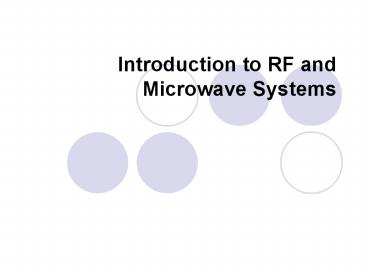Introduction to RF and Microwave Systems - PowerPoint PPT Presentation
1 / 23
Title:
Introduction to RF and Microwave Systems
Description:
Broadcasting (AM,FM radio, TV etc.) RF and Microwave Applications ... to maximum radiated power of 0.76 W, while base stations are limited to 500 W. ... – PowerPoint PPT presentation
Number of Views:2221
Avg rating:3.0/5.0
Title: Introduction to RF and Microwave Systems
1
Introduction to RF and Microwave Systems
2
RF and Microwave Frequency Bands
- RF (radio frequency) is used to indicate the
frequency band from hundreds of MHz to about 3
GHz - Microwave frequencies start from 300 MHz and goes
up to 30 GHz, ( wavelength of 1m to 0.01m) - The frequency bands above 30 GHz is called
Millimeter waves, and extend up to 300 GHz. Its
technology is very similar to microwaves.
3
Electromagnetic Spectrum
4
Electromagnetic Spectrum (comparable)
5
What is different about the RF/Microwave band?
- Circuit theory / transmission lines /
electromagnetics all needed, because - The size of the circuit (lets call it d) for
RF and microwave circuits - Question what relationship between d and
exists for (a) low frequency circuits (kHz
range), and (b) optical circuits (where the
wavelength is on the order of µm), keeping in
mind that the circuits themselves are all on the
order of cm?
6
Advantages of the use of higher frequencies
- Larger instantaneous BW for much information,
- Higher resolution for radar, imaging and sensing,
bigger doppler shift, - Reduced dimensions for components,
- Less interference from nearby applications
- Higher speed for digital systems, signal
processing, data transmission - Less crowded spectrum
- Difficulty in jamming (military)
7
Disadvantages of the use of higher frequencies
- More expensive components,
- Higher atmospheric losses,
- Reliance on GaAs instead of Si technology
- Higher components losses, lower output powers
from active devices, - Less accurate design tools, less mature
technologies.
8
RF and Microwave Applications
- Wireless Communications (space, cellular phones,
cordless phones, WLANs, Bluetooth, satellites
etc.) - Radar and Navigation (Airborne,vehicle, weather
radars, GPS, MLS, imaging radar etc.) - Remote sensing (Meteorology, mining, land
surface, aviation and marine traffic etc.) - RF Identification (Security, product tracking,
animal tracking, toll collection etc.) - Broadcasting (AM,FM radio, TV etc.)
9
RF and Microwave Applications
- Automobiles and Highways (Collision avoidance,
GPS, adaptive cruise control, traffic control
etc.) - Sensors (Temperature, moisture sensors, robotics,
buried object detection etc.) - Surveillance and EW (Spy satellites, jamming,
police radars, signal/radiation monitoring etc.) - Medical (MRI, Microwave Imaging, patient
monitoring etc.) - Radio Astronomy and Space Exploration (radio
telescopes, deep space probes, space monitoring
etc.) - Wireless Power Transmission (Space to space,
space to ground etc. power transmission)
10
Radiated Power and Safety
- Organic tissue absorbs RF and microwave energy
and converts it to heat (e.g. Microwave oven) - This is not a good thing when the tissue is you!
- Heating is dangerous to areas such as brain,
eyes, and stomach organs - Radiation may cause cataracts, cancer, and
sterility - ANSI/IEEE standard sets safety standard for
exposure limits (e.g. limited to 10 mW/cm2 above
15 GHz where radiation is absorbed by the skin) - Handheld cell phones limited to maximum radiated
power of 0.76 W, while base stations are limited
to 500 W.
11
The main purpose of the course is to provide the
following questions
- At what upper frequency does conventional circuit
analysis become inappropriate? - What characteristics make the high-frequency
behavior of electric components so different from
low-frequency behavior? - What new circuit theory has to be employed?
- How is this theory applied to practical design of
high-frequency analog circuits?
12
Sample Tranceiver
13
Power Amplifier Circuit
14
Power Amplifier PCB layout
15
(No Transcript)
16
(No Transcript)
17
(No Transcript)
18
(No Transcript)
19
RF Behavior of Passive Components
20
(No Transcript)
21
Lumped(discrete) or distributed elements
Inductor
22
(No Transcript)
23
(No Transcript)

